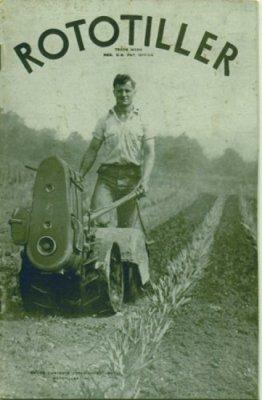 What You Should Know About Rotary Tillers - March 5, 2008 Jeff Schalau, Associate Agent, Agriculture & Natural Resources, Arizona Cooperative Extension, Yavapai County Rotary tillers make gardening medium to large areas easier to manage and save labor when preparing soil for planting. The largest rotary tillers are rear-tined, self-propelled models. Medium sized front-tined models are also popular with hobby gardeners. Lightweight cultivators have also grown in popularity in recent years. Each has relative advantages and disadvantages depending on the gardening situation and needs of the owner. The original rotary tiller was invented by Arthur Clifford Howard of New South Wales, Australia. Using various pieces from farm machinery, he rigged a drive from his father’s steam tractor engine to the shaft of a one-way notched disc cultivator. He found that the ground could be tilled without the soil-packing that occurred with normal plowing. He called this device a rotary hoe. Later it became trademarked as the “Rotovator” (also one of the longest palidromes of the English language). The first rotary tillers in the U.S. were imported from Germany and Switzerland in the 1930s. While the name “rototiller” was being used at that time, they were also called “boden frasen” or earth grinder. These were relatively large, heavy machines designed for four to ten acre farms. These machines had cast iron engines, steel tires, and rear mounted tines. In choosing a rotary tiller, you should consider how often it will be used, size of the garden area, strength of the operator, and budget. These and other factors will help you choose the right design and combination of features. If you prepare garden soil once per year, you should consider renting a rotary tiller. This may also provide the opportunity to assess whether or not you should consider purchasing one. If you garden on a small scale, a smaller rotary tiller or power cultivator may be more appropriate. Rear-tine tillers have changed very little since the 1930s and are still that standard for many small farms in developing countries. They usually have 8 hp (or larger) 4-cycle gasoline powered engines and are self-propelled. The tines rotate in the opposite direction of the wheels and they till to a depth of 8 to 10 inches. They are less demanding of the operator than other models and some advertise one handed operation. They have forward and reverse gears often having multiple gears to vary travel speed. There are also smaller “hobbyist” models. They range in price from $550 to $3,000. There are even more expensive versions called two-wheel tractors that can be fitted with a range of farm implements, but cost considerably more money. Front-tine (sometimes called mid-tine) tillers have forward rotating tines mounted in front of or just beneath the engine. These work well in small gardens and, depending on the strength of the operator, can do as good a job at tilling as rear-tined models. They require some upper body strength because the operator needs to hold the machine back while the tines are turning forward. They usually have 4-cycle engines and wheels that help move the tiller from place to place. They can till soil an inch or so deeper that the rear-tine models and range in price from $300 to $800. Lightweight cultivators are essentially mini-versions of the front-tined rotary tiller with less power. They are handy for incorporating amendments into soil and light weeding within established garden beds but can't break up rocky, uncultivated soils. They are usually powered by 2-cycle engine which require you to mix gasoline with 2-cycle oil (like chainsaws and line trimmers). There are also 4-cycle versions available. They are lightweight (about 20 lbs.) and must be carried from place to place. They usually weigh about 20 lbs and range in price from $350 to $500. Rotary tillers are often available used. These usually cost much less than a new model. If you are unsure about how to assess a used machine, bring a knowledgeable friend along and test the tiller before purchasing. Whatever your rotary tilling needs, there is a model to fit your needs and budget. The University of Arizona Cooperative Extension has publications and information on gardening and pest control. If you have other gardening questions, call the Master Gardener line in the Cottonwood office at 646-9113 ext. 14 or E-mail us at cottonwoodmg@yahoo.com and be sure to include your address and phone number. Find past Backyard Gardener columns or submit column ideas at the Backyard Gardener web site: http://cals.arizona.edu/yavapai/anr/hort/byg/. |